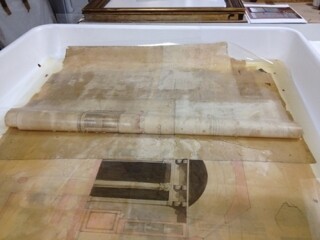Aubrey & Soane
Gillian Darley
When John Aubrey was learning to read, he found himself in a rich tilth of old manuscripts, reminders of the iconoclasm of the Dissolution a century before. His Wiltshire schoolmaster, the rector, had inherited many volumes taken from the great libraries of vandalised abbeys and priories at Malmesbury, Bath, Cirencester and elsewhere. The pages came in handy in a hundred and one ways – covering new volumes, wrapping a pair of gloves, making a serviceable lining for a storage chest, stoppering a barrel of ale. Paper was scarce and valuable, and old leases or surplus parchment scrolls had their uses for a tailor who wanted to cut out a pattern or a cook who needed to line a dish. Every sheet could find a second life.
In John Aubrey: My Own Life, Ruth Scurr conjures up the chaotic antiquarian’s agony at hearing of the witless desecration, generation after generation, of the volumes of fine calligraphy and spectacular illumination. But pulling down a volume from the shelf at school and finding it bound in ancient, inscribed vellum sparked something in the bookish eight-year-old. Chance discoveries and accidental juxtapositions were the connective tissue in his scatter-brained but remarkable life and work.
At Sir John Soane’s Museum, his labyrinthine house overlooking Lincoln’s Inn Fields, there’s an ambitious programme to conserve his framed designs and grandiose imaginary schemes. Many have hung, rarely seen, beneath the multi-leafed, hinged arrangement that Soane designed to give himself extra wall space in the first floor North Drawing Room. Kept out of the light, some have been undisturbed in their original frames and backings for two centuries. The museum’s lead conservator, Jane Wilkinson, has described the discovery of a papier-mâché ‘board’ behind a Joseph Michael Gandy watercolour. Once floated apart, it turned out to be twelve separate sheets (some used on both sides) of rejected or superseded designs, including some for the front elevation of Soane’s house.
After his death in 1837, Soane’s elaborate will instructed his executors and trustees to open a series of containers revealing the family secrets at preordained intervals. The last of them, his bathtub, was opened in 1896: the contents included papers which revealed further grim episodes in Soane’s family battles and a set of false teeth. His watercolour perspectives have turned out to be repositories of much more interesting secrets.

Comments
I too have in my possession such material as Gillian mentions; it is the dust cover of Russell's History of Western Philosophy, 2nd Edition 1947 which on the back is imprinted a map in German of Remegen and the Rhein.
Was this perhaps Wehrmacht general issue during the war and perhaps a reparation consignment of spare usable paper to us in Britain? It is still intact even after much fingering of use.